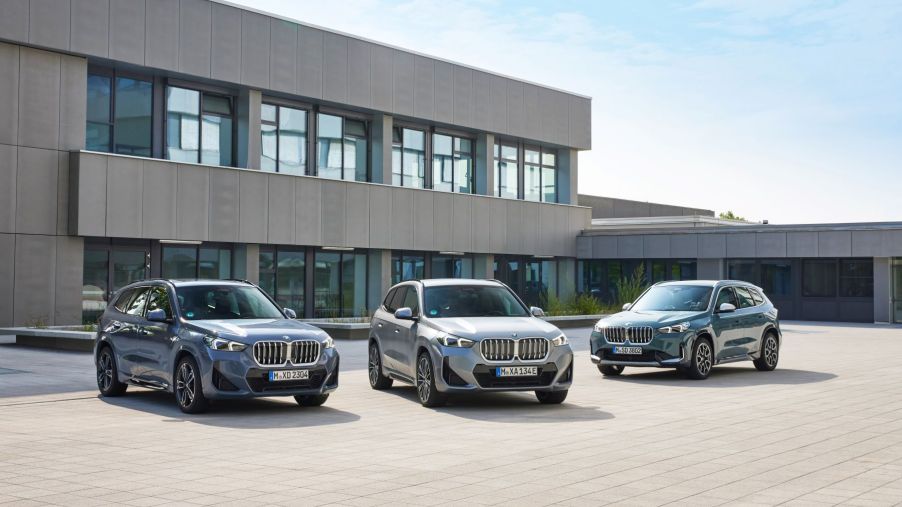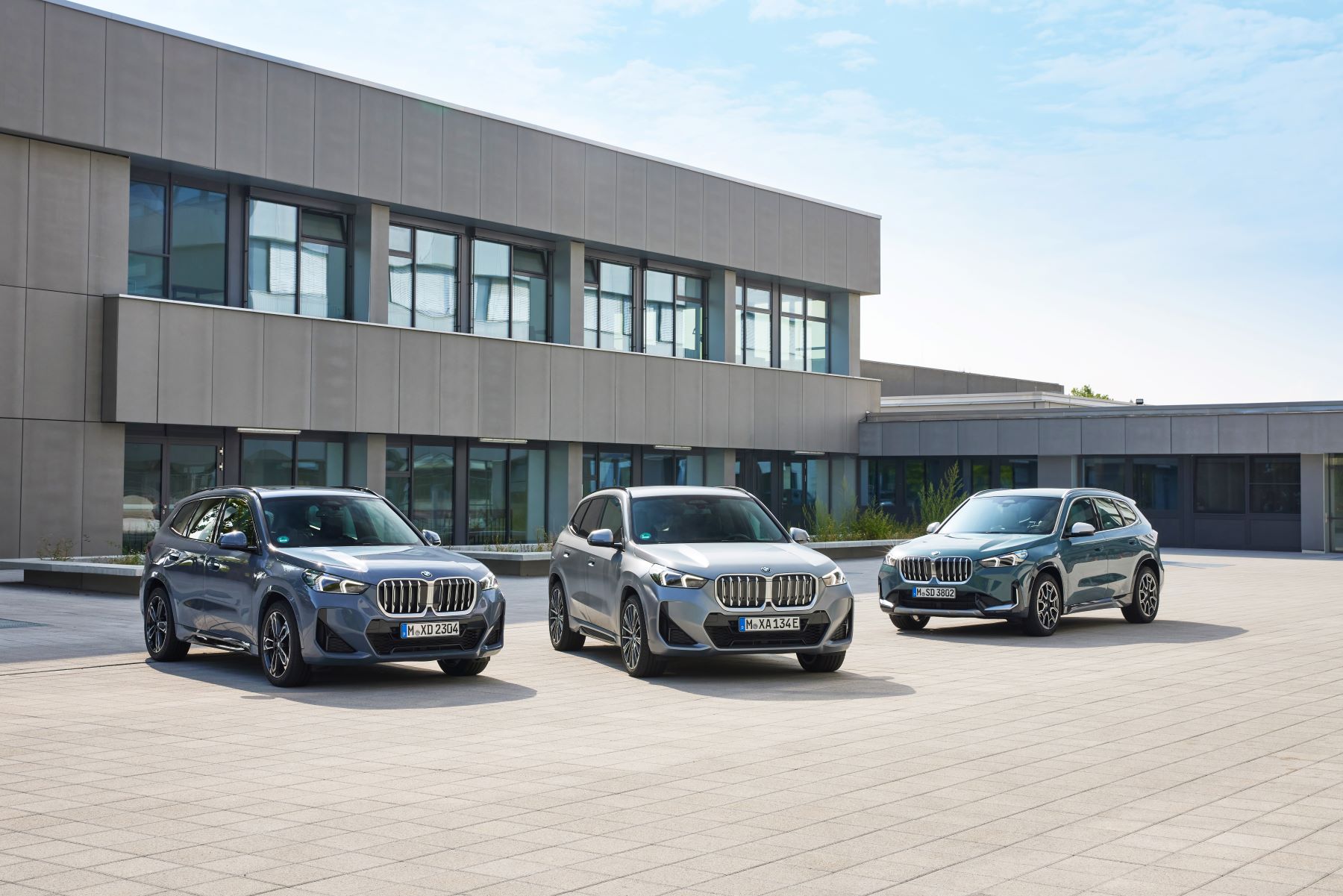
2023 BMW SUVs: A Guide to the Luxury Brand’s Latest Crossovers
If you’re able to buy a BMW SU,V but somewhat unfamiliar with the automaker’s lineup, you may be surprised to learn that its SUV line isn’t named in the most conventional way. Take Chevrolet, which gives its SUVs different names, like Trax and Suburban, designed to evoke specific brand associations and imbue its vehicles with a bit of personality. Instead, BMW names its SUVs with an X followed by a number. Hence we have the X1, X2, X3, X4, X5, X6, X7, and the standout iX. Hence, it’s difficult to tell them apart based on name alone. Here’s a brief guide to the luxury brand’s latest crossovers.
The X1

Starting at $38,600, the BMW X1 is the smallest of BMW‘s SUV lineup. It’s a fairly attractive option with a 228-hp turbocharged four-cylinder engine and an eight-speed automatic transmission. This powertrain provides solid handling and performance, as is common with BMWs.
The X1 also sports FWD standard with the base level trim, the sDrive28i. However, you can get the AWD in the higher-level trim, the xDrive28i, that BMW offers. The X1 also has a large cargo area of 27.1 cubic feet (58.7 cubic feet with the back row down).
Inside, you’ll find the kind of premium quality materials for which BMW is known. You’ll also find an 8.8-inch touchscreen standard with every trim, as well as built-in navigation, Apple CarPlay compatibility, and a seven-speaker sound system standard. The X1 is not Android Auto compatible, but that’s a small sacrifice for an otherwise superior subcompact SUV.
The X2
The BMW X2 starts a bit cheaper than the X1 at $36,600. Yet, while it’s similar in size, it’s more sporty than the X1. In fact, it could be argued it’s more a hot hatchback than a proper SUV.
You can buy an FWD sDrive28i or an AWD xDrive28i, both with the same powertrain as the X1. However, your better bet to take full advantage of the X2’s sportiness is to buy the M35i, which comes with a 302-hp turbocharged four-cylinder engine.
With the M35i, you can hit 60 mph in just 4.6 seconds. Handling is superior, given the improved powertrain, upgraded suspension, and front limited-slip differential. You’ll also enjoy a nicely trimmed interior and the same tech amenities you’ll find in the X1.
The X3
Moving up the size ladder is the compact BMW X3, with a starting MSRP of $45,500. This SUV sports different powertrain options than the X1 or X2. There’s a 248-hp 2.0-liter I-4 that comes with the sDrive30i and the xDrive30i. There’s also a mild hybrid M40i that adds a 12-volt system to the M40i variant’s 382-hp 3.0-liter turbocharged I-6 engine.
However, if you’re looking for even more performance, you can opt for the M trim, which generates 473 hp using the six-cylinder, or the M Competition, which manages to generate 503 hp.
You’ll also find the X3 has plenty of cargo space – 28.7 cubic feet behind the second row. The X3 also includes standard features of front power sport seats and dual-zone climate control. Additionally, if you opt for the M40i trim, you’ll also get two 12.3-inch displays, one for infotainment and the other for your digital instrument cluster. Android Auto is also standard.
The X4
Styled a bit differently than the X3, the BMW X4 is still as fun to drive as its corporate sibling. Starting at $53,400, the X4 looks more like a coupe than a proper SUV. Despite the different exterior, the X4 offers similar powertrain options to the X3.
The xDrive30i offers the same 248-hp producing engine. However, the M40i offers a 48-volt electrical system paired with its turbocharged inline-six engine. The X4 also includes less space than the X3 due to its design. Rather than the 28.7 cubic feet behind the second row, there is 23.7 cubic feet. There’s also a bit less headroom and legroom as well.
Still, the X4 also includes the more generous technology amenities that the X3 offers relative to the X2 or X1. For an extra charge, you can add a wireless charging pad and a 16-speaker sound system to replace the standard 12-speaker setup.
The X5
The higher the BMW number, the higher the starting price. The BMW X5 starts at $63,900, for which you can buy two or even three smaller SUVs. However, you wouldn’t have the BMW brand’s superior performance, luxury trappings, and amenities.
The X5 offers the same technology options as the X4, but where it really shines is the different powertrain options. The sDrive40i and xDrive40i come with a 335-hp 3.0-liter turbocharged inline six-cylinder coupled with a 48-volt hybrid system.
Opt for the M50i, and you’ll get a 4.4-liter turbo V8, which generated 523 hp and 553 lb-ft of torque. There’s also the X5 M which sports the same engine but can get up to 600 hp when you add the optional Competition package. Finally, there’s the plug-in hybrid xDrive45e, which pairs the sDrive40i’s inline-six with a motor that generates 389 hp and 443 lb-ft of torque.
The X6
Like the X2, the BMW X6 is in a strange niche. It’s a midsize SUV but could be described as a fastback. Starting at $70,100, you’ll find the X6 is very similar to the X5 but for its exterior styling and a few key details.
You’ll find the same various powertrain options from the X5 with the X6, providing the same confident performance and handling. When paired with the Competition package, the X6 M will generate up to 617 hp (rather than the X5’s similarly outfitted 600).
You’ll also find the X6 has a bit less cargo space than the X5. While the latter sports 33.9 cubic feet behind the second row and 72.3 cubic feet behind the first, you’ll only get 27.4 and 59.6 cubes in the X6.
Technology and optional technology upgrade packages remain the same. What you’re really paying a premium for with the X6 is souped-up performance compared to the X5.
The X7
Even more of a budget buster, the BMW X7 starts at $77,850, but you’ll get a full-size luxury vehicle superior to most in its segment.
You’ll find the same powertrain options for the xDrive40i and M50i drive trims that were available for the X6. However, if you’re looking for more power, you should opt for the Alpina XB7. This top-level trim also uses the X7’s V8 powertrain but tweaks it to generate up to 612 hp and 590 lb-ft of torque. You’ll also hit 60 mph in just 4 seconds.
As a full-size SUV, you’ll also get a generous helping of space. The X7 sports 12.8 cubic feet behind the third row, 48.6 cubic feet with the back row down, and 90.4 cubic feet with both the second and third rows down. The dual 12.3-inch touchscreens that are standard with the X3 through X6 are also standard here, and for an upcharge, you can add a head-up display.
The iX
Beyond a BMW SUV with a different naming convention, what is the iX? The iX is BMW’s all-electric SUV option, starting at $84,100. With every automaker racing to electrify their fleet, the iX is BMW’s crack at a luxury EV, and it looks like it got it right on paper.
The iX is powered by just one electric motor, but its powertrain provides drivers with 516 horsepower, 564 lb-ft of torque, and 300 miles of driving range. Like many EVs, it can hit 60 mph quite fast, with a time of just 4.6 seconds out of the gate.
If you’re looking for even more performance, opt for the iX M60, which provides 532 hp and 749 lb-ft of torque. This variant offers a Boost mode which increases horsepower to 610 hp and a Launch mode which increases torque to 811 lb-ft.
The iX comes with even more technology features than its gas-powered siblings. Accompanying the 12.3-inch touchscreen is a 14.9 control display. There’s also a standard 18-speaker sound system, four-zone climate control, and an interior camera as well.


